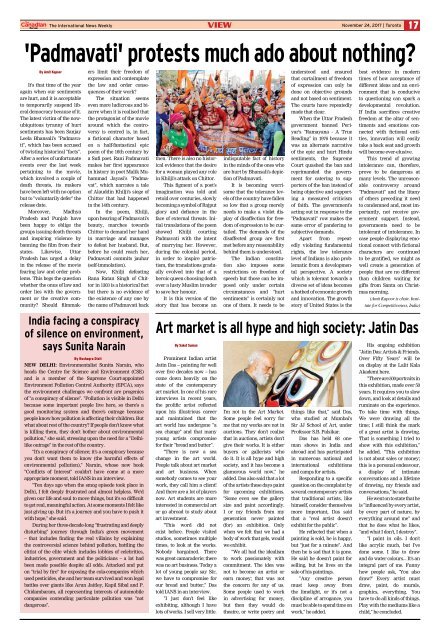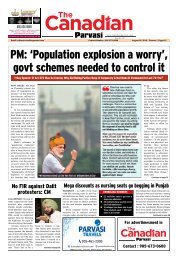You also want an ePaper? Increase the reach of your titles
YUMPU automatically turns print PDFs into web optimized ePapers that Google loves.
<strong>The</strong> International News Weekly VIEW<br />
November 24, 2017 | Toronto<br />
17<br />
'Padmavati' protests much ado about nothing?<br />
By Amit Kapoor<br />
It's that time of the year<br />
again when our sentiments<br />
are hurt, and it is acceptable<br />
to temporarily suspend liberal<br />
democracy because of it.<br />
<strong>The</strong> latest victim of the nowubiquitous<br />
tyranny of hurt<br />
sentiments has been Sanjay<br />
Leela Bhansali's "Padmavati",<br />
which has been accused<br />
of twisting historical "facts".<br />
After a series of unfortunate<br />
events over the last week<br />
pertaining to the movie,<br />
which involved a couple of<br />
death threats, its makers<br />
have been left with no option<br />
but to "voluntarily defer" the<br />
release date.<br />
Moreover, Madhya<br />
Pradesh and Punjab have<br />
been happy to oblige the<br />
groups issuing death threats<br />
and inspiring violence by<br />
banning the film from their<br />
states. Likewise, Uttar<br />
Pradesh has urged a delay<br />
in the release of the movie<br />
fearing law and order problems.<br />
This begs the question<br />
whether the onus of law and<br />
order lies with the government<br />
or the creative community?<br />
Should filmmakers<br />
limit their freedom of<br />
expression and contemplate<br />
the law and order consequences<br />
of their work?<br />
<strong>The</strong> situation seems<br />
even more ludicrous and bizarre<br />
when it is realised that<br />
the protagonist of the movie<br />
around which the controversy<br />
is centred is, in fact,<br />
a fictional character based<br />
on a half-fantastical epic<br />
poem of the 16th century by<br />
a Sufi poet. Rani Padmavati<br />
makes her first appearance<br />
in history in poet Malik Muhammad<br />
Jayasi's "Padmavat",<br />
which narrates a tale<br />
of Alauddin Khilji's siege of<br />
Chittor that had happened<br />
in the 14th century.<br />
In the poem, Khilji,<br />
upon hearing of Padmavati's<br />
beauty, marches towards<br />
Chittor to demand her hand<br />
in marriage and manages<br />
to defeat her husband. But,<br />
before he could reach her,<br />
Padmavati commits jauhar<br />
(self-immolation).<br />
Now, Khilji defeating<br />
Rana Ratan Singh of Chittor<br />
in 1303 is a historical fact<br />
but there is no evidence of<br />
the existence of any one by<br />
the name of Padmavati back<br />
India facing a conspiracy<br />
of silence on environment,<br />
says Sunita Narain<br />
By Kushagra Dixit<br />
NEW DELHI: Environmentalist Sunita Narain, who<br />
heads the Centre for Science and Environment (CSE)<br />
and is a member of the Supreme Court-appointed<br />
Environment Pollution Control Authority (EPCA), says<br />
the environment challenges we confront are progenies<br />
of "a conspiracy of silence". "Pollution is visible in Delhi<br />
because some important people live here, so there's a<br />
good monitoring system and there's outrage because<br />
people know how pollution is affecting their children. But<br />
what about rest of the country? If people don't know what<br />
is killing them, they don't bother about environmental<br />
pollution," she said, stressing upon the need for a "Delhilike<br />
outrage" in the rest of the country.<br />
"It's a conspiracy of silence; it's a conspiracy because<br />
you don't want them to know (the harmful effects of<br />
environmental pollution)," Narain, whose new book<br />
"Conflicts of Interest" couldn't have come at a more<br />
appropriate moment, told IANS in an interview.<br />
"Ten days ago when the smog episode took place in<br />
Delhi, I felt deeply frustrated and almost helpless. We'd<br />
given our life and soul to move things, but it's so difficult<br />
to get real, meaningful action. At some moments I felt like<br />
just giving up. But it's a journey and you have to push it<br />
with hope," she said.<br />
During her three-decade-long "frustrating and deeply<br />
disturbing" journey through India's green movement<br />
-- that includes finding the real villains by explaining<br />
the controversial science behind pollution, battling the<br />
elitist of the elite which includes lobbies of celebrities,<br />
industries, government and the politicians -- a lot had<br />
been made possible despite all odds. Attacked and put<br />
on "trial by fire" for exposing the cola-companies which<br />
used pesticides, she and her team survived and won legal<br />
battles over giants like Arun Jaitley, Kapil Sibal and P.<br />
Chidambaram, all representing interests of automobile<br />
companies contending particulate pollution was "not<br />
dangerous".<br />
then. <strong>The</strong>re is also no historical<br />
evidence that the desire<br />
for a woman played any role<br />
in Khilji's attack on Chittor.<br />
This figment of a poet's<br />
imagination was told and<br />
retold over centuries, slowly<br />
becoming a symbol of Rajput<br />
glory and defiance in the<br />
face of external threats. Initial<br />
translations of the poem<br />
showed Khilji courting<br />
Padmavati with the intent<br />
of marrying her. However,<br />
during the colonial period,<br />
in order to inspire patriotism,<br />
the translations gradually<br />
evolved into that of a<br />
heroic queen choosing death<br />
over a lusty Muslim invader<br />
to save her honour.<br />
It is this version of the<br />
story that has become an<br />
By Saket Suman<br />
Prominent Indian artist<br />
Jatin Das -- painting for well<br />
over five decades now -- has<br />
come down heavily on the<br />
state of the contemporary<br />
art market. In one of his rare<br />
interviews in recent years,<br />
the prolific artist reflected<br />
upon his illustrious career<br />
and maintained that the<br />
art world has undergone "a<br />
sea change" and that many<br />
young artists compromise<br />
for their "bread and butter".<br />
"<strong>The</strong>re is now a sea<br />
change in the art world.<br />
People talk about art market<br />
and art business. When<br />
somebody comes to see your<br />
work, they call him a client!<br />
And there are a lot of players<br />
now. Art students are more<br />
interested in commercial art<br />
or go abroad to study about<br />
art investment.<br />
"This word did not<br />
exist before. People visited<br />
studios, sometimes multiple<br />
times, to look at the works.<br />
Nobody bargained. <strong>The</strong>re<br />
was great camaraderie; there<br />
was no art business. Today a<br />
lot of young people say Sir,<br />
we have to compromise for<br />
our bread and butter," Das<br />
told IANS in an interview.<br />
"I just don't feel like<br />
exhibiting, although I have<br />
lots of works. I sell very little.<br />
indisputable fact of history<br />
in the minds of the ones who<br />
are hurt by Bhansali's depiction<br />
of Padmavati.<br />
It is becoming worrisome<br />
that the tolerance levels<br />
of the country have fallen<br />
so low that a group merely<br />
needs to make a violet display<br />
of disaffection for freedom<br />
of expression to be curtailed.<br />
<strong>The</strong> demands of the<br />
disaffected group are first<br />
met before any reasonability<br />
behind them is understood.<br />
<strong>The</strong> Indian constitution<br />
also imposes some<br />
restrictions on freedom of<br />
speech but those can be imposed<br />
only under certain<br />
circumstances and "hurt<br />
sentiments" is certainly not<br />
one of them. It needs to be<br />
I'm not in the Art Market.<br />
Some people feel sorry for<br />
me that my works are not in<br />
auctions. <strong>The</strong>y don't realise<br />
that in auctions, artists don't<br />
give their works. It is either<br />
buyers or gallerists who<br />
do it. It is all hype and high<br />
society, and it has become a<br />
glamorous world now," he<br />
added. Das also said that a lot<br />
of the artists these days paint<br />
for upcoming exhibitions.<br />
"Some even see the gallery<br />
size and paint accordingly.<br />
I or my friends from my<br />
generation never painted<br />
(for) an exhibition. Only<br />
when we felt that we had a<br />
body of work that gels, would<br />
we exhibit.<br />
"We all had the idealism<br />
to work passionately with<br />
commitment. <strong>The</strong> idea was<br />
not to become an artist or<br />
earn money; that was not<br />
the concern for any of us.<br />
Some people used to work<br />
in advertising for money,<br />
but then they would do<br />
theatre, or write poetry and<br />
understood and ensured<br />
that curtailment of freedom<br />
of expression can only be<br />
done on objective grounds<br />
and not based on sentiment.<br />
<strong>The</strong> courts have repeatedly<br />
made that clear.<br />
When the Uttar Pradesh<br />
government banned Periyar's<br />
"Ramayana - A True<br />
Reading" in 1976 because it<br />
was an alternate narrative<br />
of the epic and hurt Hindu<br />
sentiments, the Supreme<br />
Court quashed the ban and<br />
reprimanded the government<br />
for catering to supporters<br />
of the ban instead of<br />
being objective and supporting<br />
a measured criticism<br />
of faith. <strong>The</strong> government's<br />
acting out in response to the<br />
"Padmavati" row makes the<br />
same error of pandering to<br />
subjective demands.<br />
Apart from repeatedly<br />
violating fundamental<br />
rights, the low tolerance<br />
level of Indians is also problematic<br />
from a developmental<br />
perspective. A society<br />
which is tolerant towards a<br />
diverse set of ideas becomes<br />
a hotbed of economic growth<br />
and innovation. <strong>The</strong> growth<br />
story of United States is the<br />
things like that," said Das,<br />
who studied at Mumbai's<br />
Sir JJ School of Art, under<br />
Professor S.B. Palsikar.<br />
Das has held 68 oneman<br />
shows in India and<br />
abroad and has participated<br />
in numerous national and<br />
international exhibitions<br />
and camps for artists.<br />
Responding to a specific<br />
question on the complaint by<br />
several contemporary artists<br />
that traditional artists, like<br />
himself, consider themselves<br />
more important, Das said<br />
that a "real artist doesn't<br />
exhibit for the public".<br />
He reflected that when a<br />
painting is sold, he is happy,<br />
but "just for a minute". And<br />
then he is sad that it is gone.<br />
He said he doesn't paint for<br />
selling, but he lives on the<br />
sale of his paintings.<br />
"Any creative person<br />
must keep away from<br />
the limelight, or it's not a<br />
discipline of arrogance, you<br />
must be able to spend time on<br />
work," he added.<br />
best evidence in modern<br />
times of how acceptance of<br />
different ideas and an environment<br />
that is conducive<br />
to questioning can spark a<br />
developmental revolution.<br />
If India sacrifices creative<br />
freedom at the altar of sentiments<br />
and emotions connected<br />
with fictional entities,<br />
innovation will easily<br />
take a back seat and growth<br />
will become ever-elusive.<br />
This trend of growing<br />
intolerance can, therefore,<br />
prove to be dangerous at<br />
many levels. <strong>The</strong> unreasonable<br />
controversy around<br />
"Padmavati" and the litany<br />
of others preceding it need<br />
to condemned and, most importantly,<br />
not receive government<br />
support. Instead,<br />
governments need to be<br />
intolerant of intolerance. In<br />
case people displaying emotional<br />
connect with fictional<br />
characters are continued<br />
to be gratified, we might as<br />
well create a generation of<br />
people that are no different<br />
than children waiting for<br />
gifts from Santa on Christmas<br />
morning.<br />
(Amit Kapoor is chair, Institute<br />
for Competitiveness, India)<br />
Art market is all hype and high society: Jatin Das<br />
His ongoing exhibition<br />
"Jatin Das: Artists & Friends.<br />
Over Fifty Years" will be<br />
on display at the Lalit Kala<br />
Akademi here.<br />
"<strong>The</strong>re are 500 portraits in<br />
this exhibition, made over 50<br />
years. It requires you to slow<br />
down, and look at details and<br />
ruminate on the experience.<br />
To take time with things.<br />
We were drawing all the<br />
time; I still think the mark<br />
of a great artist is drawing.<br />
That is something I tried to<br />
show with this exhibition,"<br />
he added. "This exhibition<br />
is not about sales or money;<br />
this is a personal endeavour,<br />
a display of intimate<br />
conversations and a lifetime<br />
of drawing, my friends and<br />
conversations," he said.<br />
He went on to state that he<br />
is "influenced by every artist,<br />
by every part of nature, by<br />
everything around me" and<br />
that he does what he likes,<br />
"and what I don't, I destroy".<br />
"I paint in oils. I don't<br />
like acrylic much, but I've<br />
done some. I like to draw<br />
and do water colours... It's an<br />
integral part of me. Funny<br />
how people ask, 'You also<br />
draw?' Every artist must<br />
draw, paint, do murals,<br />
graphics, everything. You<br />
have to do all kinds of things.<br />
Play with the mediums like a<br />
child," he concluded.

















